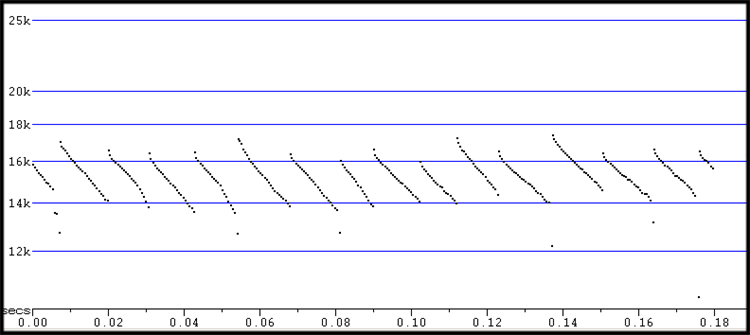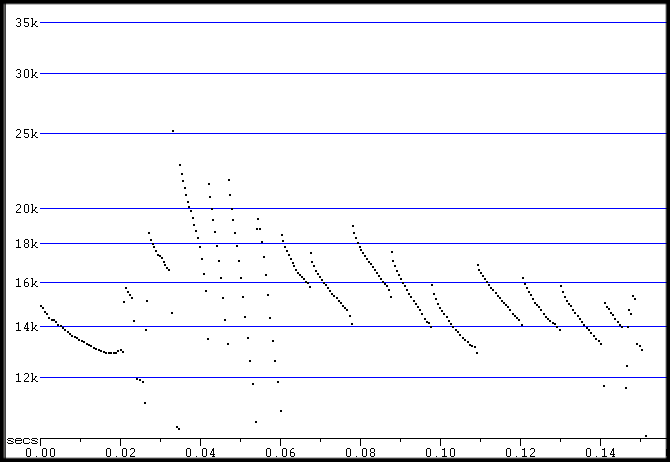Molossidae
Guide for Acoustic Identification of Florida bats
Eumflo or Eufl
See glossary for explanation of codes
Eumops floridanus (G. M. Allen, 1932)
Taxonomy follows Simmons and Cirranello (2021)












To view call graphics click on the camera icon on the right. You can then move through all images by using the left or right arrow keys. A left mouse click returns to the fact sheet.
Search phase calls are single QCF pulses decreasing in frequency. A wide range of example call shapes and types are provided
This should be a species that is easy to confirm acoustically by evaluating complete call sequences. While the 90th percentile of calls range around 16 kHz, it is the only bat regularly emitting search phase calls below 15 kHz.
However, those without experience in identifying calls of all species occurring in Florida may confuse commute calls of Taderida brasiliensis, Lasiurus cinereus or social calls of Nycticeius humeralis with calls of E. floridanus. This may result in false positive identification. Several examples are included for comparison. Auto identification algorithms may also flag these calls as Eumflo incorrectly.
Hand release calls are considerably higher in frequency than free flying search phase calls. Clutter calls recorded at roosts and feeding buzzes are also considerably higher in frequency than free flying diagnostic search phase calls. These higher range of frequencies from such recordings are not useful as reference calls as they may be confused the other free flying species. Note: The various auto-ID algorithms often incorrectly flag such pulses as those of other species..
Search phase calls
| Parameters | N | Min | Max | Mean | St.Dev | 10% | 25% | 75% | 90% |
| Dur | 1110 | 5.0 | 22.0 | 10.8 | 3.4 | 6.2 | 8.2 | 13.1 | 15.7 |
| TBC | 984 | 62.6 | 14653.9 | 805.6 | 917.1 | 390.5 | 474.7 | 741.0 | 1331.6 |
| Fmin | 1110 | 10.2 | 19.2 | 14.1 | 1.3 | 12.7 | 13.2 | 14.8 | 15.9 |
| Fmax | 1110 | 12.6 | 25.3 | 17.2 | 2.0 | 15.1 | 15.9 | 18.5 | 19.8 |
| BW | 1110 | 0.8 | 8.7 | 3.1 | 1.1 | 1.8 | 2.3 | 3.8 | 4.7 |
| Fmean | 1110 | 12.1 | 21.0 | 15.3 | 1.5 | 13.7 | 14.2 | 16.1 | 17.3 |
| Fk | 1110 | 12.6 | 21.8 | 16.2 | 1.6 | 14.4 | 15.0 | 17.2 | 18.4 |
| FcH1 | 1110 | 5.9 | 9.9 | 7.4 | 0.7 | 6.6 | 6.8 | 7.8 | 8.4 |
| Fc | 1110 | 11.9 | 19.9 | 14.7 | 1.4 | 13.1 | 13.7 | 15.5 | 16.7 |
| FcH3 | 1110 | 17.8 | 29.8 | 22.1 | 2.1 | 19.7 | 20.5 | 23.3 | 25.1 |
| Sc | 1110 | -47.2 | 117.6 | 23.1 | 9.8 | 12.9 | 18.3 | 27.4 | 32.9 |
| Pmc | 1110 | 1.0 | 30.9 | 16.9 | 6.7 | 8.1 | 11.9 | 22.0 | 26.7 |
| Parameters | N | Min | Max | Mean | St.Dev | 10% | 25% | 75% | 90% |
| Dur | 1110 | 5.0 | 22.0 | 10.8 | 3.4 | 6.2 | 8.2 | 13.1 | 15.7 |
| TBC | 984 | 62.6 | 14653.9 | 805.6 | 917.1 | 390.5 | 474.7 | 741.0 | 1331.6 |
| Fmin | 1110 | 10.2 | 19.2 | 14.1 | 1.3 | 12.7 | 13.2 | 14.8 | 15.9 |
| Fmax | 1110 | 12.6 | 25.3 | 17.2 | 2.0 | 15.1 | 15.9 | 18.5 | 19.8 |
| BW | 1110 | 0.8 | 8.7 | 3.1 | 1.1 | 1.8 | 2.3 | 3.8 | 4.7 |
| Fmean | 1110 | 12.1 | 21.0 | 15.3 | 1.5 | 13.7 |
| Parameters | N | Min | Max | Mean | St.Dev | 10% | 25% | 75% | 90% |
| Dur | 251 | 0.8 | 44.5 | 8.9 | 6.5 | 2.0 | 4.9 | 11.0 | 14.9 |
| TBC | 236 | 1.7 | 2874 | 428 | 429 | 44 | 181 | 491 | 759 |
| Fmin | 251 | 10.0 | 20.9 | 15.0 | 1.6 | 13.2 | 14.0 | 15.9 | 17.1 |
| Fmax | 251 | 14.6 | 29.8 | 19.6 | 3.1 | 16.4 | 17.5 | 20.7 | 23.9 |
| BW | 251 | 0.3 | 15.7 | 4.6 | 3.1 | 1.4 | 2.4 | 5.7 | 8.8 |
| Fmean | 251 | 14.5 | 22.1 | 16.7 | 1.5 | 14.9 | 15.5 | 17.6 | 18.4 |
| Fk | 251 | 10.0 | 21.9 | 17.3 | 1.7 | 15.7 | 16.3 | 18.2 | 19.7 |
| Fc | 251 | 14.0 | 22.4 | 16.1 | 1.5 | 14.5 | 15.0 | 16.9 | 18.1 |
| Sc | 251 | -610.4 | 356.5 | 23.5 | 79.5 | 9.0 | 20.9 | 39.0 | 62.8 |
| Pmc | 251 | 0.0 | 81.4 | 22.2 | 17.2 | 3.7 | 10.5 | 29.6 | 41.1 |
Cynthia and George Marks
Bruce Miller
Reference calls recorded by Marks and Miller are being archived at BioAcoustica and will be freely available. See Baker et al., (2015).
|
|
Florida Fish and Wildlife Conservation Commission (2018)
Federal Status: Endangered
FL Status: Federally-designated Endangered
FNAI Ranks: G5T1/S1 (Globally: Demonstrably Secure, Sub Sp. Critically Imperiled/State: Critically Imperiled)
IUCN Status: Vulnerable C2a(i)- population trend decreasing I.U.C.N. (2018)
The Florida bonneted bat is protected as an Endangered species by the Federal Endangered Species Act and as a Federally-designated Endangered species by Florida’s Endangered and Threatened Species Rule.
See FWC (2018)
See Bailey et al,. (2017) for predicted distributions and Baker et. al., (2015) for discussion of BioAcoustica and Baker and Vincent (2019) for a critique of the lack of freely available acoustic data.
Bailey, A. M., H. K. Ober, A. R. Sovie, and R. A. McCleery. 2017. Impact of land use and climate on the distribution of the endangered Florida bonneted bat. Journal of Mammalogy. 98: 1586-1593.
Belwood, J.J. 1992. Florida mastiff bat Eumops glaucinus floridanus. Pages 216-223 in S.R. Humphrey (ed.), Rare and endangered biota of Florida. Vol. I. Mammals. University Press of Florida. Gainesville, Florida.
Baker, E., B. W. Price, S. D. Rycroft, J. Hill, and V. S. Smith. 2015. BioAcoustica: a free and open repository and analysis platform for bioacoustics. Database. 2015. bav054
Baker, E., and S. Vincent. 2019. A deafening silence: a lack of data and reproducibility in published bioacoustics research? Biodiversity Data Journal 7: e36783.
Florida Fish and Wildlife Conservation Commission (2018); Florida Bonneted Bat: Eumops floridanus: myfwc.com/wildlifehabitats/imperiled/profiles/mammals/florida-bonneted-bat
Marks, C. S., and G. E. Marks. 2006. Bats of Florida. Pp. 176. University of Florida Press, Gainesville.
Simmons, N. B., and A. L. Cirranello. 2020. Bat Species of the World: A taxonomic and geographic database. http://batnames.org
The IUCN 2018. Red List of Threatened Species. Version 2017-3. www.iucnredlist.org;. Downloaded on June 2, 2018
Timm, R. M., and H. H. Genoways. 2004. The Florida bonneted bat, Eumops floridanus (Chiroptera: Molossidae): distribution, morphometrics, systematics, and ecology. Journal of Mammalogy 85:852-865.





